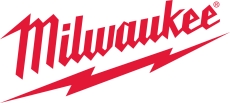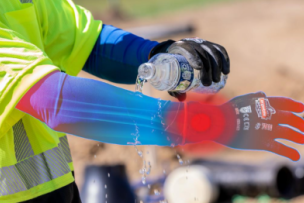Summer is here and most contractors and construction companies will see an influx of jobs. A busy schedule often means teams are working in high temperatures, which can have dangerous effects. Here are the five key tips to beating the heat on work sites all summer long.
1. KNOW THE SIGNS OF HEAT STRESS AND HEAT STROKE
Heat stress and heat exhaustion are among the most common jobsite issues during hot days. Knowing the signs is one of the most important ways to help your team as they work long summer hours. Untreated, heat stress can lead to heat stroke, which can be fatal. Experts attribute more than one-third of worksite deaths across the U.S. to this condition. Nearly 75% of those deaths occurred in June, July and August.
The following are common symptoms of heat stress and are a sign that the worker needs to rest and cool down.
- Heavy sweating: Sweating is the body’s way of trying to cool itself when your internal temperature rises. While it’s normal to sweat on a hot jobsite, getting drenched in sweat or sweating where you normally don’t could be a sign of heat exhaustion.
- Excessive thirst: It’s important to stay hydrated on hot days but an unsatisfied thirst could mean that the body is eliminating the water through sweat faster than it can rehydrate.
- Dizziness: Heat stress involves dehydration and a rising body temperature, both of which can make you feel like you just got off of a tilt-a-whirl, even when standing or sitting.
- Nausea: When your body experiences dehydration from heat stress, you could feel nauseated — which makes it even harder for you to take in water and electrolytes.
- Weakness: As your body heats up, you become weaker, making it harder for you to hold things and walk confidently.
If you notice these symptoms in yourself or a teammate, take them to a cool area to rest, loosen their clothing and have them sip cold water. Symptoms should begin to improve within an hour. If there is no improvement, get medical help.
Without fast action, heat stress can turn into heat stroke, which is more serious and requires a 911 call. Experiencing that condition means the person’s body loses its ability to regulate its temperature, leading to life-threatening complications.
Symptoms of heat stroke include the following.
- Dizziness: Also a sign of heat stress, dizziness could indicate that a worker’s condition is already turning into heat stroke.
- Confusion: A telltale sign that someone has heat stroke is confusion about where they are or what they are doing.
- Unconsciousness: Falling unconscious means the body is too overwhelmed by the heat to function properly.
While heat stress treatment is urgent, heat stroke treatment is an emergency. Call 911 immediately and take the person to a cool place. Remove any layers of clothing items and work to reduce their body temperature by placing cold water and ice on them.
Stay with the person until paramedics arrive. They will take the worker for emergency treatment at the hospital. Acting fast could prevent permanent disability or even save their life.
Educate all of your workers about the symptoms and dangers of both heat stress and heat stroke. Provide virtual and physical documents of the symptoms and treatment plans to each worker so they can easily refer to them if they suspect they or someone else is falling ill.
2. KEEP SUNSCREEN ON-SITE
Any skin exposed to high levels of ultraviolet radiation can cause sunburn. In addition to being uncomfortable or painful, burns can cause your workers' bodies to retain more heat, increasing the likelihood of heat stress or stroke.
Sunburns also have long-term effects, increasing the risk of a skin cancer diagnosis. The pain and itching from a burn increase a worker’s stress level, which can lead to high blood pressure and rapid heart rate — both conditions exacerbated by high temperatures.
Aside from the clothing your workers wear, the best way to prevent a sunburn is by applying sunscreen. Encourage them to bring their own sunscreen if they have a preference but keep some on-site for everyone to use at any time. On average, workers should reapply sunscreen every two hours, but it is important to follow the directions on each bottle since specifics may differ.
There are two types of sunscreen — chemical and physical. Physical sunscreens use minerals that sit on the skin’s surface to repel the sun’s rays, while the ingredients in chemical sunscreen sink into the skin to protect against sun damage.
Workers might prefer chemical sunscreen if:
- They want a lightweight formula.
- They want to avoid a white cast on their skin.
Someone might want a physical sunscreen if:
- They have sensitive skin.
- They want more protection.
Any sunscreen used should have a sun protection factor (SPF) of at least 15 to block more than 90% of the sun’s harmful rays. For the most protection, an SPF 100 sunscreen should block around 99% of UV rays when properly applied.
3. MAKE HYDRATION A TOP PRIORITY
Hydration is key to making it through a hot workday without damaging your body. It is important to keep your team drinking water and electrolytes throughout the day.
The amount of hydration necessary is unique to each individual but a good rule of thumb is to drink eight ounces of water or other hydrating liquid every 15-20 minutes when working on a hot jobsite. This guideline helps ensure everyone gets what they need to keep their bodies running optimally.
Providing both water and electrolyte drinks like Gatorade or Powerade can help your workers replace both the water and nutrients their body loses through sweat. You are going to go through a lot of these products, so it is important to budget for them.
While you should encourage your workers to bring hydration of their choice, there is no guarantee that they will always remember to do it. The water bottles they do bring might get warm, making it hard to drink and reducing some of the liquid’s cooling potential. Keeping enough drinks in coolers will provide everyone access to cold beverages through the workday. Doing so will help them stay happy, safe and healthy.
Educate your workers about why hydrating is so important. In the heat, they shouldn’t wait until they feel thirsty to take sips of cool liquid. Providing liberal access to on-site restrooms can encourage them to drink up since they won’t worry about where they’ll go to relieve themselves after drinking. In fact, not going to the bathroom at least once every two to three hours on a hot day could be a sign that dehydration is setting in.
4. PROVIDE THE RIGHT EQUIPMENT
Part of your job as a leader on a construction site is to make sure everyone is wearing the right personal protective equipment (PPE). The equipment needs for workers vary between seasons with heat-resistant options necessary during high temperatures.
Here is what you should consider providing for all workers throughout the summer months:
HEAT-PROTECTANT HARD HATS
Light-colored hard hats do a better job of keeping workers cool than those with darker colors. That’s because light colors absorb less heat than dark colors, decreasing the amount of heat that warms your workers’ bodies.
A wide brim will shade your workers’ faces, protecting them from harmful UV rays and lowering the temperature in that area of their body. If there are no electrical hazards, consider providing hard hats with vents that allow for more airflow.
The BOLT™ System from Milwaukee® even has an extended sun visor and sunshade attachments that provide 360° UV protection.
COOLING VESTS
Modern cooling vests keep a set temperature for a period of time, helping your team stay cool and protected throughout each day.
To get the most out of these vests, encourage each worker to wear breathable fabrics underneath them. You could even supply a lightweight UV-protectant shirt to wear underneath the vest to protect each person from the heat and damaging rays.
EYE PROTECTION
Sunglasses are helpful when doing recreational activities in the heat, but workers often need something stronger on a construction site. However, normal safety goggles might not deflect the sun’s glare, making it harder for workers to see, endangering them.
Safety sunglasses are the perfect combination of anti-glare, UV protective sunglasses with the secure fit and strong lenses of safety goggles.
HAND PROTECTION
You want each worker to have lightweight, heat-resistant work gloves. Often made with terry cloth or silicon, these gloves can protect against burns when working with or around metal and other hot surfaces.
High temperatures can cause your team’s hands to sweat more easily, making it harder to grip tools and controls. Silicone grips can make a huge difference when handling different items. If someone is more than six feet off the ground, secure them with a fall arrest system that can keep them safe if they do slip.
The right PPE, along with proper equipment and site inspections, will ensure the safest environment possible for your workers.
5. LOOSEN YOUR BREAK POLICY
While construction deadlines can get tight, it’s necessary to put the health and safety of your team first. The summer is a great time to loosen up your break schedules, allowing anyone to walk off the site to cool down, reapply sunscreen, rest and hydrate. These actions keep their bodies healthy and able to work in hot temperatures, and each worker knows their bodies best.
Some people might require more breaks than others and there is no shame in that. It takes time to acclimate to working in the heat. Around 50%-70% of heat-related deaths on work sites happen in the first few days due to a lack of acclimation.
If there are no shady trees or awnings nearby, set up shelters around the work site for everyone to indulge in some shade on their breaks. These spots will give their skin and eyes a break from the sun while allowing them to decrease their body temperature.
Consider a group dinner break or end time around 3:00 p.m. since that is when the sun will be hottest. Trying to work during the coolest parts of the day may change how you schedule each day but it will help keep your team healthy and productive throughout each project.
KEEPING YOUR TEAM SAFE THIS SUMMER
Your business can’t survive without the men and women who put their hard work into each project. As a leader, it is necessary to take steps to keep them safe during long summer days. When you keep these tips in mind, you will help each worker stay healthy and happy.
Previously Featured on Milwaukee's blog.
Browse PPE from Milwaukee to keep your workers safe from the heat this summer on MSCDirect.com.

.png?itok=RCf0Q-X3)


max_efficiency_thumb.png?itok=_OhRZeS3)




Talk to Us!
Leave a reply
Your email address will not be published. Required fields are marked *